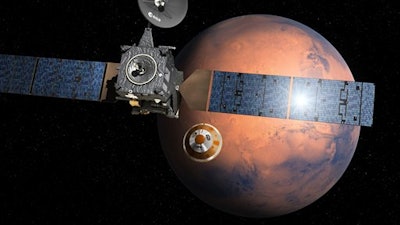
BERLIN (AP) — The European Space Agency planned to land an experimental probe on Mars Wednesday as part of an international mission to analyze the red planet's atmosphere and hunt for signs of life.
The Schiaparelli lander was released from its mother ship Sunday. Scientists said the gentle approach would turn into a six-minute hell ride when the probe dives into the hot, dusty Martian atmosphere at 1442 GMT Wednesday and hurtles toward the surface at 21,000 kilometers an hour (13,050 mph).
If all goes to plan, Schiaparelli will deploy a parachute and then thrusters to slow down to 10 kph (6.2 mph) before hitting the surface.
Landing a spacecraft on Mars is notoriously difficult and several past missions have failed, including the European Space Agency's previous attempt in 2003 with the rover Beagle 2. It made it to Mars but its solar panels didn't unfold properly, preventing it from communicating.
While Schiaparelli has some scientific instruments on board, its main purpose is to rehearse the landing and test technology for a European rover mission to Mars in 2020. NASA has successfully placed several robotic vehicles on the planet, including the Opportunity and Curiosity rovers.
ESA's mission control center in Darmstadt, Germany, expects to receive confirmation that Schiaparelli has landed at about 1630 GMT. Detailed data from the lander aren't expected before 1815 GMT.
Schiaparelli left for Mars in March aboard a Russian rocket together with its mother ship, the Trace Gas Orbiter.
The orbiter, which also has NASA-made instruments on board, will analyze methane and other gases in the atmosphere.
Methane is created by biological or geological activity and breaks down within a few hundred years once it reaches the atmosphere, suggesting there is biological or geological activity on Mars now or in the recent past.
The prospect of finding even microscopic organisms on Mars has excited scientists for some time, but so far none has been discovered.
The ExoMars program, which comprises the current and 2020 mission, is ESA's first interplanetary mission jointly undertaken with the Russian space agency Roscosmos.






















